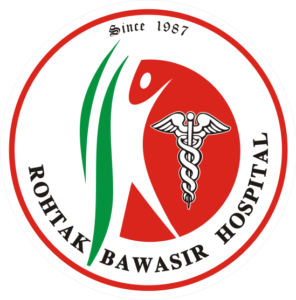Healing Hemorrhoids: The Ultimate Guide to Piles Treatment


Updated on: 4th Jun 2024
Introduction
Hemorrhoids, sometimes referred to as piles, are painful, bleeding bulging veins in the lower rectum and anus. For those impacted, knowing the illness’s causes, symptoms, and therapies can greatly enhance their quality of life. This resource from Rohtak Bawasir Hospital explores the various approaches to treating hemorrhoids and provides information on both prescription and non-prescription treatments.
Understanding Hemorrhoids

There are two forms of hemorrhoids: internal and external. External hemorrhoids form beneath the skin surrounding the anus, whereas internal hemorrhoids are found inside the rectum. While both kinds can cause discomfort, itchiness, and bleeding, there may be differences in how they are treated.
Causes
- Straining during bowel movements : The most frequent cause, which is frequently brought on by constipation, is straining during bowel motions.
- Chronic diarrhea or constipation : Hemorrhoids can result from either constipation or persistent diarrhea.
- Sitting for long periods : Long-term sitting: Especially when using the restroom.
- Obesity: Carrying extra weight puts strain on the pelvic veins.
- Pregnancy : Hemorrhoids can occur during pregnancy due to changes in hormones and increased strain on the abdomen.
- Anal intercourse : Rectal veins may get irritated and inflamed during anal sex.
Symptoms
- Bleeding: Typically painless, with bright red blood after a bowel movement.
- Discomfort and pain: Especially during bowel movements or when sitting.
- Swelling around the anus: A lump near the anus can be painful.
- Itching and irritation: Around the anal region.
- Leakage of feces: In severe cases.
Diagnosis
Hemorrhoids are usually diagnosed by physical examination. An anoscopy or digital rectal exam (DRE) may be necessary in certain situations. In order to rule out other disorders and establish the presence of hemorrhoids, these methods aid in seeing the rectum and anal canal.
Treatment Options

The severity of hemorrhoids determines the course of treatment. Here, we list the best therapies—from over-the-counter medications to surgical procedures—in brief.
Home Remedies
- Dietary Changes: Consuming more fruits, vegetables, and whole grains can increase fiber intake, which will soften stools and lessen straining. Getting enough of water is also beneficial.
- Warm Sitz Baths: Several times a day, soaking the anal region in warm water for ten to fifteen minutes will help alleviate symptoms.
- Topical Treatments: Witch hazel and hydrocortisone are two over-the-counter lotions and ointments that can help lessen pain and inflammation.
- Cold Compresses: Compressing the area with ice packs helps ease pain and swelling.
- Regular Exercise: Engaging in physical activity helps alleviate vein pressure and prevent constipation.
Medical Treatments
Non-Surgical Procedures: Minimally invasive techniques may be recommended by doctors for hemorrhoids that are moderate to severe.
- Rubber Band Ligation: To stop blood flow and cause the hemorrhoid to wither and fall off, a rubber band is wrapped around its base.
- Sclerotherapy: The hemorrhoid is made smaller by injecting a chemical solution into it.
- Infrared Coagulation (IRC): Hemorrhoids are treated by cutting off their blood supply with infrared light.
Surgical Procedures:Surgery could be required for hemorrhoids that are severe or persistent.
- Hemorrhoidectomy: the surgical excision of hemorrhoids, typically carried out while sedated.
- Stapled Hemorrhoidopexy: In order to stop the bleeding and cause the hemorrhoids to shrink, this surgery entails stapling them back into place inside the rectum.
Preventive Measures
Adopting good lifestyle practices to stay away from the main causes of hemorrhoids is essential to preventing the problem.
- High-Fiber Diet: Aim for 20–35 grams of fiber from whole grains, fruits, and vegetables each day.
- Stay Hydrated: To maintain soft stools, consume eight glasses of water or more each day.
- Regular Exercise: lessens vein pressure and aids in maintaining regular bowel motions.
- Avoid Straining: Avoid exerting yourself or using force when passing gas.
- Don’t Delay: To prevent straining, use the restroom as soon as you sense the need.
- Limit Sitting Time: To relieve strain on the anal veins, particularly when using the toilet.
When to Seek Medical Attention

While minor hemorrhoid symptoms can be managed with over-the-counter medications and home remedies, certain indicators call for medical attention from a qualified practitioner:
- Excessive Bleeding: If bleeding is heavy or persistent, get help.
- Severe Pain: especially if using over-the-counter remedies doesn’t make a difference.
- Inability to Control Bowel Movements: Fecal incontinence may be a sign of more serious hemorrhagic issues.
- Lump: An excruciating lump around the anus could be a sign of a thrombosed hemorrhoid.
- Changes in Bowel Habits: Abrupt alterations in the habits or consistency of the stools.
Conclusion
Although hemorrhoids can be an unpleasant and uncomfortable condition, they can be properly controlled with the right knowledge and care. In order to provide patients with the best care possible, Rohtak Bawasir Hospital provides comprehensive care, including sophisticated treatment choices and diagnosis. Don’t wait to consult a doctor if you’re having hemorrhoidal symptoms; there are plenty of treatment alternatives available to help you feel better and feel better about yourself.
Meet Our Specialists

Dr. Raj Kumar Garg (B.A.M.S.)
40+ Years of Experience

Dr. Rahul Garg (B.A.M.S.)
15+ Years of Experience

